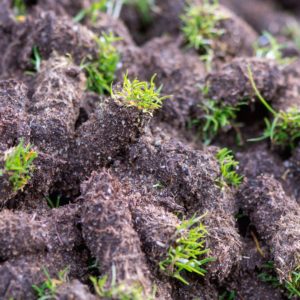Seeding a Lawn (Part 2)
 Once your soil is prepared, the actual seeding process is a breeze. Simply spread out the right amount of grass seed, and make sure it gets enough water.
Once your soil is prepared, the actual seeding process is a breeze. Simply spread out the right amount of grass seed, and make sure it gets enough water.
For larger lawns, you might need to use a walk-behind seed spread to make the job a bit easier. For smaller areas, a simple hand held spreader should do the trick. Make sure to spread your seed evenly throughout, and don’t over do it. A moderate peppering is all that’s required. Once you have your seed laid down, grab a plastic rake, turn it upside down, and gently use the back of the tines to massage the seeds into the soil. Not much force is needed in this step, make sure to use short and very light strokes, long heavy strokes can bunch up your seed and cause uneven growth in some areas.
Watering – Make sure to water your newly seeded soil regularly, you can use either an oscillating sprinkler or a fan sprinkler, as long as the water is evenly distributed. If you don’t have a sprinkler, a simple hose sprayer attachment on the mist setting will also do the trick. Be sure to move the sprinkler on to a new, unwatered area after approximately 10 minutes. Around 10 minutes of watering, two or three times a day, should be plenty for the first couple of weeks. Once the seeds begin to sprout, cut it back to one watering per day for around 15 to 20 minutes. It’s best to schedule your watering more toward the early morning and noon time, that way the soil has more time to absorb and less evaporation takes place. If you receive a fair amount of rain during the day, you will not need to set your sprinklers out until the following day – don’t drown your seed. Also, avoid watering late in the evening or at night, this can result in fungal diseases.
If you have any large trees near the area you are seeding, be sure to thin the branches to allow more sunlight to pass through to the soil. Once your grass has begun to grow, be sure to water the soil under your large trees once or twice a week during periods without rainfall, to make sure the grass doesn’t get starved by the tree roots absorbing all the moisture in the soil.
And that’s it! Before you know it, you’re new grass will be growing high enough to start mowing your lawn again.

